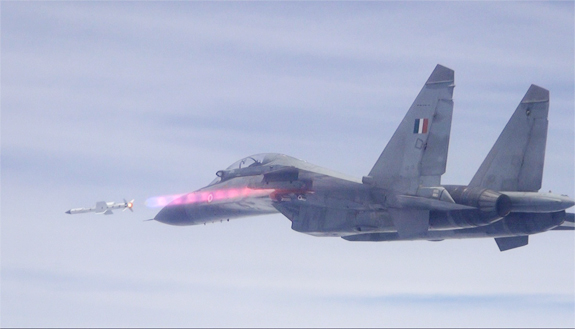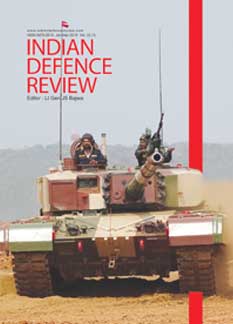The multi-dimensional growth of air threat over time has taken place mainly along two major verticals. The first of these is the multiplicity of air threat vehicles. In that, the erstwhile duo of aircraft (ac) and helicopters (heptrs) as main threat vehicles, are today joined by a multi-dimensional strike punch consisting of Attack Helicopters (AHs), Unmanned Aerial Systems/ Vehicles (UAS/UAVs), Tactical Ballistic Missiles, Cruise Missiles, Precision Guided Munitions (PGMs), Anti Radiation Missiles (ARMs) and the now emerging soft-kill offensive weapons. The other vertical is the spatial growth of the threat in all its three dimensions of range, reach (implying altitude) and hours of applicability. Starting from the early seventies when the air threat was prosecuted mainly in the visual domain of the defenders using mostly short range guns and a small arsenal of unguided rockets and missiles, today, the capability is to strike deep with precision and accuracy from long ranges standing off hundreds of miles away from the defender’s visual domain.
The unmanned revolution has taken over with its unmatched capability of all weather, all terrain operations with incredible endurance and no crew fatigue…
Fundamentally, since the raison-de-etre for the existence of air defence, be it on land, sea or in the air, is to counter the air threat from the adversary, an assessment of the same, both in terms of quality and quantum, must therefore become the ab initio of all deliberations concerning air defence.
The Cause-Effect Relationship
The term ‘air threat’ essentially implies the cumulative potential danger which the adversary holds, as his capability to cause damage and destruction to our vulnerabilities through the use of aerial threat vehicles and munitions in furtherance of, or in support of his war effort on land and sea. This danger is basically assessed in two dimensions. First, is the qualitative dimension which includes the lethality, severity and technological advancement of the adversary’s air threat vehicles while the second, is the quantitative dimension that relates to the numbers which constitute the air threat punch. Accordingly, the defender aims to put together such resources on land, sea and air that can counter the threat defined as above. Thus, the air threat on one side and the means of air defence on the other, are tied to each other in an eternal cause-effect relationship.
The Two Verticals Of Metamorphosis
The multi-dimensional growth of air threat over time has taken place mainly along two major verticals. The first of these is the multiplicity of air threat vehicles. In that, the erstwhile duo of aircraft (ac) and helicopters (heptrs) as main threat vehicles, are today joined by a multi-dimensional strike punch consisting of Attack Helicopters (AHs), Unmanned Aerial Systems/Vehicles (UAS/UAVs), Tactical Ballistic Missiles, Cruise Missiles, Precision Guided Munitions (PGMs), Anti Radiation Missiles (ARMs) and the now emerging soft-kill offensive weapons.
The 4th and 5th generation war machines are truly multi-role, structurally lighter, detection resistant, and carry an array of onboard sensors with a packaged Electronic Warfare (EW) suit for survivability and sustainability…
The other vertical is the spatial growth of the threat in all its three dimensions of range, reach (implying altitude) and hours of applicability. Starting from the early seventies when the air threat was prosecuted mainly in the visual domain of the defenders using mostly short range guns and a small arsenal of unguided rockets and missiles, today, the capability is to strike deep with precision and accuracy from long ranges standing off hundreds of miles away from the defender’s visual domain. Also strike with multiple vehicles any time of the day or night, remain nearly invisible to defenders’ radars, employ the unmanned with its multiple combat virtues and hit both with hard and soft kill munitions.
Manifestation Of Metamorphosis Over Threat Vehicles
The revamping-transformation of the air threat over time as stated above is spread over the multiple threat vehicles, most prominently on the aircraft of today. These 4th and 5th generation war machines are truly multi-role, structurally lighter, detection resistant, carry an array of onboard sensors with a packaged Electronic Warfare (EW) suit for survivability and sustainability and are armed to the teeth with smart and intelligent munitions including the PGMs. The AHs are All Weather (AW) with avionics providing the technological muscle for Nap Of Earth (NOE) operations.
The unmanned revolution has taken over with its unmatched capability of all weather, all terrain operations with incredible endurance and no crew fatigue. Multiplicative affects are being achieved by Manned and Unmanned Teaming (MUMT) and the missiles, both in the Surface-to-Surface (SSM) and Air to Surface (ASMs) modes are scaling new dimensions in range, reach and kill probabilities. The soft kill weapons are emerging in three domains, viz, laser, Charged Particle Beams (CPBs) and High Power Microwaves (HPM).
A brief analysis of air threat from Pakistan and China follows:–
Pakistan
The mission of the Pakistan Air Force (PAF) is to provide, in synergy with the other Services, the most efficient, assured and cost effective aerial defence of Pakistan.1 The PAF has an inventory of some 450 combat aircraft organised into 20 front line squadrons. It operates four main types of combat aircraft namely, the French Mirage V attack aircraft (90), Mirage III interceptors (90), the Chinese J-7 fighters (39) and the JF 17 multi-role aircraft (86) and the US F-16 multi-role strike aircraft (76). It is reported that by 2025, the PAF will only operate two multi-role aircraft, namely F-16 and JF-17.2
Over a period of time, the old and obsolete aircraft – A5, F6, Super F7 and the FT7P have been phased out. The F-16s have undergone major upgrade to include NATO compatible Link 16 communications, GPS/INS flying, weapon upgrade to include High speed ARMs, PGMs, Stand-Off weapons and wind-corrected munitions dispensers. The JF-17 has been operationalised with high grade weaponry, night-flying capability and electronic warfare package. Similarly, Mirages have been put through systems and weapon pack upgrades.
The JF-17 has been operationalised with high grade weaponry, night-flying capability and electronic warfare package…
Talking of Attack Helicopters (AHs), the PAF has a fleet of AH 1F Huey Cobras (two squadrons 32 helicopters) and the Chinese K-8 (one squadron of 28). AH IFs have seen upgrades involving Forward Looking Infra Red (FLIR) night sights and Tube-launched, Optically-tracked Wire-guided (TOW) missiles. Besides AHs, the PAF operates a small fleet of UAS to include ASN 105, 106 from China, Snipe and Streak from the UK and Luna from Germany. In September 2015, Pakistan became the ninth nation in the world to develop and use an armed UAS named Burraq. It is armed with Barq, an ASM that can strike with a high degree of precision.
Under the Armed Forces Development Programme, (AFFDP 2006-2019, the PAF besides procuring some modern combat aircraft from US and China, has acquired several cutting-edge systems. These include PGMs for J-17 aircraft (LS6 and LS6P and SD10A Beyond Visual Range Missiles). Other known PGMs and ASMs with the PAF are Shrike Anti Radiation Missiles (ARM), Laser Guided Bombs (LGBs), Maverick missile and AS 30 ASM useable with Mirages (III&V) and F 16 aircraft. As regards the cruise missile, Nasr (HATF IX) is a solid fuel tactical ballistic missile developed as short range (60 km) high accuracy low yield battlefield deterrent.
On September 19, 2017, the PAF announced that it will acquire three new Saab 2000 Erieye Airborne Early Warning and Control (AEW&C) aircraft. This will join the three existing Erieye and four Y8600 based ZDK03 AEW&Cs, taking a total of such aircraft to ten by the end of the decade.3 The first of these aircraft is likely to be delivered by December 2017 and the balance two by December 2018. This will provide a tangible enhancement in the airborne surveillance and targeting capability of the PAF. It has also been reported that Pakistan is in talks with China to acquire 30 to 40 J-F31 stealth fighters. This will add a totally new qualitative dimension to its strike capability. In the unmanned category, while the Burraq represents the front edge UAVs from China (ASN 105A, ASN 206, B2B,) UK (snipe Mk II), Germany (Luna), Italy (Falcon), South Africa (Seeker) besides the indigenous (Bravo, Ababeel, Baaz, AWC Mk I & II, Vision I, Shaper, Vector, Huma 1 and Thunder constitutes the unmanned fleet . Some implications from the PAF capability which needs be factored into our quality and quantum calculation of air defence resources on a tri-service format is covered below:
It has also been reported that Pakistan is in talks with China to acquire 30 to 40 J-F31 stealth fighters…
• 20 combat squadrons of PAF comprising 17 strike, four multi-role and three air defence aircraft squadrons.
• There has been a continuous qualitative upgrade wherein the dead weight of old and vintage aircraft are being done away with sharp focussing the fleet to four major front-line strike aircraft types such as the F-16 series, Mirage III/V and J7/JF17.
• There has been a continuous attempt to re-vamp the threat beyond aircraft in terms of AH, Cruise Missiles, ARMs, SSMs, UAS and PGMs.
• A limited ni/AW attack capability and a tangible mix of EW capability stands inducted in front-line aircraft.
• Limited induction of AWACs and AAR capability provides force multiplier effect.
• The front edge of the strike force now features the stealth threat which needs to be addressed by the defenders.
• The known radii-of-action of the front-line combat aircraft provides the capability to PAF to strike India’s hinterland making the strategic assets located in depth, highly vulnerable.
China
In keeping with China’s high growth trajectory, the People’s Liberation Army Air Force (PLAAF) has followed an impressive growth profile. From a near antiquated status in around 1990-1991, the PLAAF is more operationally capable today than any time in its past.
In keeping with China’s high growth trajectory, the People’s Liberation Army Air Force (PLAAF) has followed an impressive growth profile…
As a part of a major revamp of its air power, its earlier inventory of some 5,000+ aircraft that included some 2,000 obsolete aircraft stand right-sized to about 3,000 aircraft (2755-30104) in which, the combat edge is held by J-7 (fighter-388), JH-7 (fighter bomber – 70), H6 (strategic bomber-120), Su 30 (air superiority fighter 76), J-8 (Interceptor 96), J-10 (multi role fighter – 237), J-11 (air superiority fighter – 196), Q5 (strike aircraft – 118) aircraft.
Taking pride in flying the first prototype of its latest Stealth Fighter (J-20) in January 2011, ostentatiously at a time when the US Secretary of Defence, Robert Gates was in Beijing, the PLAAF is steadily modernising. Predictions on future PLAAF fleet indicate that it will consist of large numbers of ChengduJ-10 and Shenyang J-11 as the mainstay platforms and JH-7A as the PLAAF’s backbone precision strike fighter. The J-20 is likely to enter the PLAAF around 2018.5,6
The future transport fleet of the PLAAF is likely to be anchored around the Y-9 medium range transport aircraft duly supported by the IL fleet. The AH inventory is likely to be populated by WZ-10, WZ-9 and Z-11. The AWACS fleet is likely to have refined variants of KJ2000 and KJ200 and a reported (50, unconfirmed) numbers of similar platforms are likely to be imported from Russia.
The Aviation Industry Corporation of China (AVIC) is reported to be working on six developmental combat aircraft programmes. These include the significantly enhanced Chengdu J-10B multi-role fighter, Shenyang J-11B5 heavyweight strike fighter, Shenyang J-15 carrier-borne fighter and Chengdu J-20 fifth generation fighter demonstrator. There is at least one more fifth generation fighter project yet to be publically reported. Besides this, the continuing enhancement of current frontline types such as the JH 7A and H-6 bomber family is in progress.7






